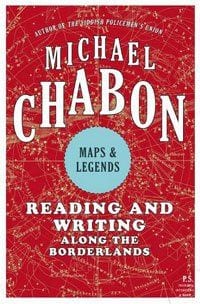
In the late 19th and early 20th centuries, my public librarian predecessors believed that most fiction, especially what we now know as genre fiction, was bad for their patrons’ best interests, like rock candy to a dentist. Patrons would be lucky if fiction filled more than a small fraction of a collection and fictional material was intended to be morally, culturally and intellectually edifying. Pilgrim’s Progress? Sure. Pride and Prejudice? Perhaps.Pride and Prejudice and Zombies? Not likely. While I now catalog more Danielle Steele audiobooks than anyone should have to, I’m happy to see the shelves populated with books that people actually want to read — for their moral edification, or (Victorians be damned!) for the fun of it.
The existence of a writer like Michael Chabon, and his critical and public reception, indicates how far readers have progressed with the concept of genre fiction, and, simultaneously, how we can still be a bunch of bourgeois snobs. Chabon’s novels playfully appropriate aspects of genre from the crime thriller to fantasy. In his first collection of essays, Maps and Legends: Reading and Writing Along the Borderlands, Chabon wrestles with the concept of genre and ultimately defends and promotes it, if only for what he deems to be its positive aesthetic qualities. That is, genre fiction can teach a writer about plotting, suspense, and, when it comes to the subject of fans and their homespun fictions, the relationship between reader and author.
The collection’s first essay, “Trickster in A Suit of Lights: Thoughts On the Modern Short Story”, introduces many of Chabon’s main arguments. He praises entertainment, calling it “the only sure means we have of bridging, or at least of feeling as if we have bridged, the gulf of consciousness that separates each of us from everybody else.” Stories, he argues, are ultimately about connection. He goes on to discuss the conventions of genre, the rules and the importance of breaking them. Anyone who bemoans the staid, vaguely historical and breathy toned “literary” novel will enjoy Chabon’s argument that the genre of “literary fiction” has its own rules, too. And like the best romance or mystery novelists, the best literary novelists play with their genre’s conventions. This first essay also brings a definition of the “borderlands” in the book’s title which is the name Chabon gives to “the spaces between genres…the no man’s land” where writers from A.S. Byatt to Kurt Vonnegut have “drawn immense powers” when crafting their own fictions.
Several pieces in the book have been culled from Chabon’s articles in the New York Review of Books where he often takes on authors and books that have transcended genre. Of course, referring to this as a ‘transcendence’ — which Chabon rarely, if ever, does — only perpetuates the notion that genres are ghettoes. The reviews are a mixed bag. His essay on Philip Pullman’s magnificent His Dark Materials trilogy spends too much space summarizing and draws some lackluster conclusions:
His Dark Materials ends not as a riposte to Lewis or a crushing indictment of authoritarian dogma but as an invocation of the glory, and a lamentation for the loss…of the idea of childhood as an adventure.
It’s only because Chabon is capable of writing provocative essays that I find the latter a bit dull. One of the strongest essays in the collection is Chabon’s review of Cormac McCarthy’s The Road and his discussion of how and why the post-apocalypse is a place literary authors can flex their genre muscle. Here, Chabon displays his ability to question the bookish establishment, such as reviewers’ need to excuse their enjoyment of a good plot, for example, by contextualizing genre fiction in other terms like “fable” instead of “science fiction.”
Readers of Chabon’s The Adventures of Kavalier and Clay expecting essays on comics heroes both on and off the page will not be disappointed. His short essay, “Kids’ Stuff”, makes a cogent argument for comics while providing the reader with a history of their reception in America and their changing readership. The collection also includes pieces on Howard Chaykin’s American Flagg!, Will Eisner, and Julius Knipl.
The latter half of Chabon’s collection features personal essays that provide great insight into the composition of his first novel, The Mysteries of Pittsburgh, and a bloated second novel-that-never-was but one which inspired a character in Wonder Boys, nonetheless. These essays serve as a sort of B-side to Chabon’s fiction as we are given access to his personal iconography and influences — everything from the map of the Maryland planned community in which he was raised, to his relationship with Judaism, fascination with golems, and his first taste of negative press (in the form of some seriously annoyed scholars of Yiddish.) The final essay, taken from a lecture Chabon gave on several occasions, both sustains and questions the concept of truth and fact in fiction. The author’s most impressive skill as an essayist is his ability to distance himself from his own work and discuss it with some degree of objectivity as when he criticizes his own “literary fiction” in the essay on short stories, and when he questions the verisimilitude of his remembrance of childhood memories that have nonetheless influenced his life and writing.
There are few literary authors like Michael Chabon who, Pulitzer Prize and all, are willing to not only defend but work within a mode of writing that was at one time known only by the cheapness of its production: pulp. Chabon is a worthy guide whose essays, like a good adventure story, take readers to new regions on the map (even if your next stop is only as exotic as the Sword and Sorcery section of the book shop.)
